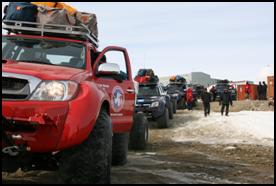Antarctic challenge is “snow” problem for Hilux trucks
A CONVOY of Toyota Hilux trucks have completed yet another extraordinary journey, travelling across the coldest, most hostile environment in the world, Antarctica, to reach the South Pole.
Already well known for overcoming extreme challenges, from driving to the North Pole to conquering the Icelandic volcano Eyjafjallajökull, four Hilux transported expedition members of the Indian National Centre for Antarctic and Ocean Research (NCAOR) − studying snow chemistry, glacial landscapes and the bedrock hidden beneath the ice − on a 4,600km round trip from Novo Air Base, to the South Pole, and safely back.
The four Hilux vehicles were adapted by Icelandic Toyota 4×4 conversion specialists, Arctic Trucks, for the month-long expedition.
Faced with extreme weather, average temperatures of below -40C and peaks of -56C altitudes of over 3,400m and the most brutal driving environment imaginable, NCAOR selected the Hilux for this remarkable expedition as it combines several attributes essential to survival on the world’s harshest continent.
Firstly, given the extreme conditions, it has proven very low comparable fuel consumption of 5.65mpg. Even with the use of less energy-efficient Jet 1A fuel, the vehicle engine running 24/7 and running extra heating system constantly on, this figure is 5 to 8 times lower than that achieved by tracked vehicles. This significantly reduces both transported fuel loads and fuel costs (one barrel of oil in Antarctica can cost $10,000). With this fuel efficiency, the expedition could rely on only one refueling point, established some 1,500 km from the journey starting point – Maitri Antarctica station.
Secondly, the Hilux has a uniquely high load carrying capacity. It combines a low unladen weight of just 2.2 tons with a payload capacity of 1.5 tons and a towing capacity of 3 tons – an essential attribute when carrying the expedition equipment, spare parts and participants, as well as 1,280 litres of fuel per vehicle.
Thirdly, this expedition maintained a faster average speed than any comparable expedition had previously attained.
Modifications made by Arctic Trucks included the integration of a crane to lift heavy equipment and fuel, the use of Jet 1A fuel with additional lubricants to tackle the extreme cold, revised front/rear suspension and drivetrain, extra heating system, crawler gears, crevasse protection and the fitment of extra large tyres with a pressure as low as 20psi.



